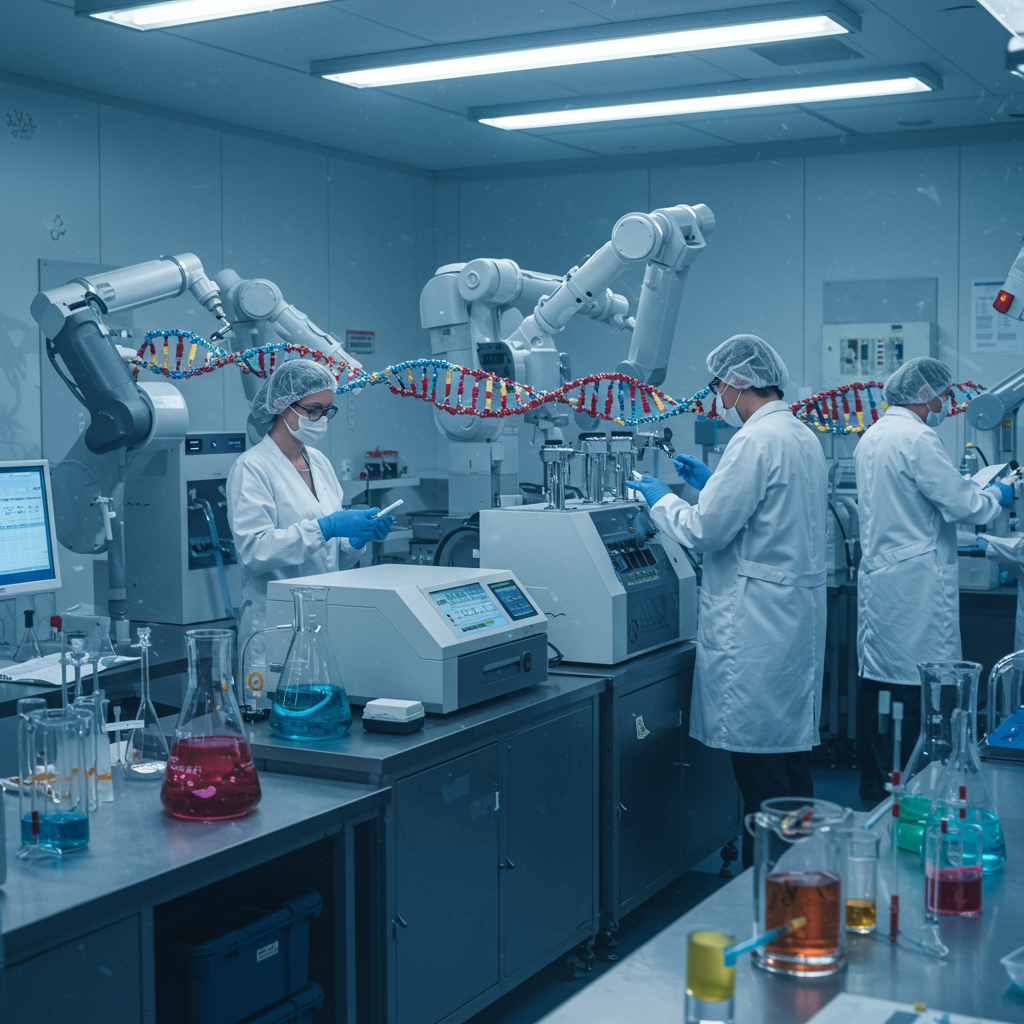Scientists are embarking on an ambitious and ethically charged project to synthesize complex sections of human DNA from fundamental chemical building blocks. This groundbreaking work, seen by some as venturing into territory akin to “playing God,” aims to unlock revolutionary treatments for conditions ranging from autoimmune disorders and heart failure to viral infections and age-related diseases. The ultimate vision is the construction of entire human chromosomes, a significant leap toward potentially assembling a complete synthetic human genome in the laboratory.
This undertaking involves developing sophisticated tools capable of assembling large, intricate DNA sequences. Researchers plan to introduce these lab-created DNA segments into skin cells to meticulously study their function and behavior. Unlike gene editing techniques that modify existing DNA, building DNA from scratch grants scientists unprecedented control to explore genetic processes and rigorously test novel biological theories.
Crafting Life’s Code: The Science Behind Synthetic DNA
DNA, or deoxyribonucleic acid, is the fundamental molecule carrying the genetic instructions that define all living organisms. Found in nearly every cell of the human body, DNA is composed of a simple alphabet of just four chemical bases: Adenine (A), Guanine (G), Cytosine (C), and Thymine (T). The specific sequence and arrangement of these four bases in countless combinations create the unique genetic code that dictates everything from physical traits like eye color to an individual’s susceptibility to certain diseases.
Synthesizing DNA means chemists and biologists are creating these complex sequences in a test tube, letter by letter, rather than obtaining them from existing biological samples. This de novo creation provides a level of precision and control over the genetic sequence that is simply not possible with traditional methods. By building sequences with specific modifications or entirely novel arrangements, researchers can directly investigate the impact of these changes on cell function and development.
A Collaborative Effort Across Leading UK Universities
Over the next five years, a significant collaborative effort involving researchers from several prominent UK institutions is set to drive this research forward. Teams at the University of Oxford, Cambridge, Kent, Manchester, and Imperial College London are pooling their expertise to build and test synthetic DNA structures.
The immediate objective of this multi-institutional project is to deepen our understanding of how DNA fundamentally influences human development, health, and the complex processes of aging. By constructing genetic material from the ground up, scientists can design experiments to isolate the effects of specific DNA sequences and regulatory elements, providing clearer insights into their roles. This allows for a more direct approach to studying genetic function compared to merely making small alterations to existing biological systems.
Potential Health Benefits and Future Therapies
Scientists believe this synthetic DNA research holds immense potential for future medical breakthroughs. A primary goal is to better understand the mechanisms by which malfunctioning cells trigger disease. By building specific faulty DNA sequences, researchers can recreate disease states in the lab and observe their progression, potentially identifying new therapeutic targets.
The work could pave the way for revolutionary medical applications years down the line. This includes the potential creation of disease-resistant tissues engineered to withstand specific pathogens or conditions. Techniques to repair damaged organs like the heart or liver could be developed by using synthetic DNA to guide cellular regeneration. Furthermore, the technology could contribute to advancements in lab-grown organs for transplantation or sophisticated cell-based medicine, where engineered cells are introduced into the body to treat illness.
Dr. Julian Sale from Cambridge’s MRC Laboratory of Molecular Biology highlighted that this technology allows researchers to explore the vast, often overlooked regions of the human genome. These areas, sometimes referred to as the “dark matter” of the genome, do not directly code for proteins but are suspected to play critical roles in regulating gene activity and overall cellular function. Building and testing synthetic sequences in these regions could reveal previously unknown biological mechanisms.
Professor Matthew Hurles from the Wellcome Sanger Institute added that synthesizing DNA from scratch is a powerful tool for validating biological theories. It enables researchers to test hypotheses about how DNA works in ways that are difficult or impossible when limited to manipulating existing genetic material within living organisms.
Applications Beyond Human Health
The potential applications of synthetic biology extend beyond the human genome itself. For instance, the technology could lead to the creation of synthetic mitochondria. These cellular powerhouses carry their own small circle of DNA, and defects in mitochondrial DNA can cause severe inherited disorders. Philosophy professor Iain Brassington from the University of Manchester suggested that synthesizing healthy mitochondria could offer a way for women with these conditions to have children without relying on egg donors, by potentially introducing synthetic healthy mitochondria into their own egg cells.
Beyond human biology, synthetic DNA could be used to engineer microorganisms for industrial or environmental purposes. Examples include creating bacteria designed to clean up oil spills or digest plastic waste, offering innovative solutions to pressing global challenges.
Urgent Ethical and Safety Concerns Emerge
Despite the promising potential, the prospect of creating synthetic human DNA from scratch has ignited serious ethical and safety concerns among experts and observers. Critics warn that the technology carries potentially catastrophic risks if misused or released without proper safeguards.
One major fear is the possibility of this powerful technology being repurposed for malicious intent, such as the creation of novel biological weapons. The ability to design and synthesize specific genetic sequences could theoretically be used to engineer highly virulent pathogens or toxins.
Another significant concern revolves around the potential for creating genetically engineered “designer babies.” While the current research focuses on understanding fundamental biology and developing therapies, the capacity to build and insert complex human DNA sequences raises questions about future attempts to select or enhance human traits non-therapeutically.
Experts caution that once the capability and equipment to synthesize complex genetic material are widespread, controlling how the technology is used becomes incredibly difficult. As one professor noted, it may be impossible to stop organizations with the right resources from synthesizing harmful substances if they are determined to do so. A genetic ethics campaigner echoed this sentiment, stressing that even research started with benevolent intentions could be diverted for harmful purposes, including warfare.
The potential environmental impact of releasing synthetic organisms is also a significant worry. Professor Brassington highlighted that lab-engineered bacteria designed for cleanup could have unpredictable and potentially devastating consequences if they escaped into natural environments, disrupting ecosystems or causing unforeseen harm. The accidental release of such “bugs” into the environment is described as having potentially catastrophic outcomes.
Balancing Innovation and Responsibility
The scientific endeavor to build synthetic human DNA represents a frontier in biology with immense potential to deepen our understanding of life and develop life-saving therapies. It offers unprecedented control over genetic material, opening doors to research avenues previously unimaginable.
However, the ethical and safety questions raised are profound and require careful consideration. The capacity to create the fundamental building blocks of life from scratch necessitates robust oversight, international collaboration, and open dialogue about the boundaries and responsibilities associated with such powerful technology. While the promise of treating devastating diseases drives the research, the warnings about potential misuse for biological weapons, unintended environmental consequences, or ethically fraught applications like designer babies cannot be ignored. The path forward requires navigating this complex landscape with caution, foresight, and a commitment to prioritizing human and environmental safety alongside scientific advancement.
Frequently Asked Questions
What is synthetic human DNA and how is it created?
Synthetic human DNA is genetic material built piece by piece in a laboratory using chemical synthesis, rather than being isolated from existing biological organisms. Scientists assemble the DNA sequence letter by letter (A, G, C, T) from fundamental chemicals. This process allows for the creation of specific, custom DNA sequences, including large and complex sections of human chromosomes, offering researchers precise control not possible with natural DNA manipulation.
What are the main ethical and safety risks associated with creating synthetic human DNA?
Experts warn of several significant risks. A primary concern is the potential for the technology to be misused to create biological weapons, such as novel pathogens or toxins. There are also fears about the possibility of genetically engineering “designer babies” by selecting or enhancing traits. Additionally, releasing synthetically engineered organisms, like bacteria designed for cleanup, into the environment could have unpredictable and potentially catastrophic ecological consequences.
Which UK universities are involved in synthesizing human DNA, and what are their goals?
Several leading UK universities are collaborating on this project over the next five years, including the Universities of Oxford, Cambridge, Kent, Manchester, and Imperial College London, with contributions from the Wellcome Sanger Institute. Their immediate goals are to build and test synthetic DNA in the lab to better understand its role in human development, health, and aging. The longer-term goals include unlocking new treatments for various diseases by understanding how faulty cells function and potentially developing novel therapies like virus-resistant tissues or lab-grown organs.




